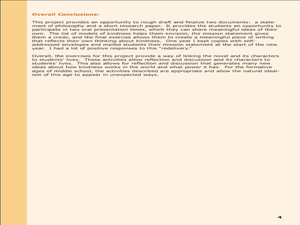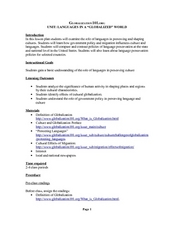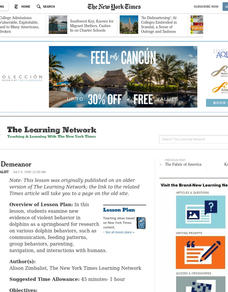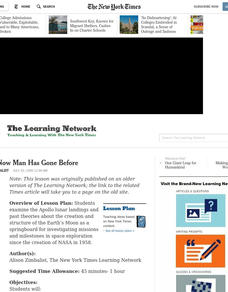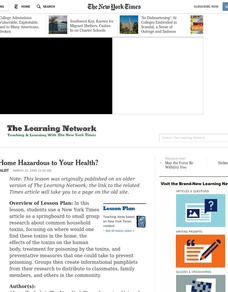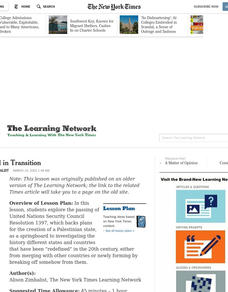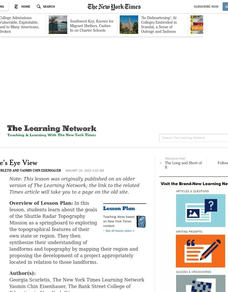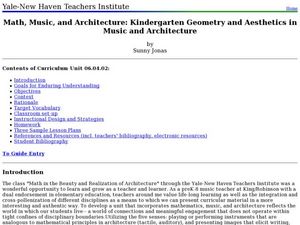Curated OER
Busting More Myths Using the Scientific Method
Use the Mythbusters model to jazz up your scientific method lessons!
Curated OER
Heroes, Kindness and "To Kill A Mockingbird"
Students read To Kill a Mockingbird and relate the action sof the characters to behaviors in students lives. In this heroism, bullying, kindness and compassion lesson plan, students identify characters who are heroes in the story....
Curated OER
Languages in a Globalized World
Students explore language changes that may occur in a globalized world. In this language lesson, students read the linked articles about globalization and the protection of languages. Students also examine statistics and conduct further...
Curated OER
Dalai Lama Peace and Conflict Resolution
Students explore philosophy by researching the Dalai Lama. In this peaceful living lesson, students discuss the Dalai Lama and his unique views of the world before reading the story Can You Say Peace? Students answer study questions...
Curated OER
Density
Students determine the density of different substances. In this physical science lesson, students rank them according to their density. They discover the relationship between volume and density.
Curated OER
Disposable Diaper Comparison and Mystery Powder Identification
Students investigate which diaper is the most absorbent. In this chemistry lesson, students calculate how much water is absorbed by diapers. They identify an unknown powder based on physical and chemical properties.
Curated OER
A (Class)Room of One's Own
Students assess the educational and social issues of boys and girls in school as a springboard to interviewing women in the fields of science, in order to study of their early interests and experiences in these typically male-dominated...
Curated OER
Dolphin Demeanor
Young scholars examine new evidence of violent behavior in dolphins as a springboard for research on various dolphin behaviors, such as communication, feeding patterns, group behaviors, parenting, navigation, and interactions with humans.
Curated OER
Curious Crossbreeds
Students discover the diverse roles of hybridization among animals. They research certain examples of animal hybrids as a springboard to analyzing a zoo's potential exhibit of animal hybrids.
Curated OER
Freedom of Hate Speech?
Students, using a New York Times article as a springboard for discussion, investigate and debate the complex issues of First Amendments Rights and censorship for Hate Groups using Websites for propaganda.
Curated OER
Where Now Man Has Gone Before
Students examine the Apollo lunar landings and past theories about the creation and structure of the Earth's Moon as a springboard for investigating missions and milestones in space exploration since the creation of NASA in 1958.
Curated OER
A Meat By Any Other Name. . .
Students, using a New York Times article as a springboard, discuss how food reflects different aspects of a culture and reasons why cultural differences in food are seen as bizarre or, oftentimes, cruel by members of other societies.
Curated OER
Is Your Home Hazardous to Your Health?
Learners use a newspaper article as a springboard to small group research about common household toxins, focusing on where would one find these toxins in the home, the effects of the toxins on the human body and treatment for poisoning...
Curated OER
Explosive Knowledge
Learners examine China's suspected theft of American nuclear secrets, as a springboard for the creation of a research-based, multi-tiered timeline that traces the development, regulation, and use of nuclear weapons from the 1940's to today.
Curated OER
A World in Transition
Students explore the passing of United Nations Security Council Resolution 1397, which backs plans for the creation of a Palestinian state, as a springboard to investigating the history different countries that have been redefined in the...
Curated OER
A Shuttle's Eye View
Students explore the goals of the Shuttle Radar Topography Mission as a springboard to exploring the topographical features of their own state or region. They synthesize their understanding of landforms and topography by mapping their...
Curated OER
Fire Escape
Learners explore the effects of the volcanic eruption of Nyiragongo in Congo as a springboard to exploring past examples of volcanic eruptions and their respective relief efforts.
Curated OER
The Physics of Sound: How We Produce Sounds
Students are introduced to how they produce sounds. In groups, they participate in experiments in which they measure sound and identify their five senses. Individually, they make their own musical instruments using different objects and...
Curated OER
Picasso And Family
Learners view Pablo Picasso's sculpture "Baboon and Young" and use it as a springboard to discuss their conceptions of the term family. They use a collection of discarded manmade objects to create an animal sculpture.
Curated OER
Create An Insect
Learners create a new species of insect. They create a list of insect characteristics and use this as a springboard to draw an insect of their own. Students write a brief descriptive paragraphs about their insect, giving particular...
Curated OER
Our World of shapes
First graders listen to Shapes and The Greedy Triangle to identify and describe examples of geometric shapes. In this geometric shapes lesson, look for geometric shapes in real world places. Students make a mobile of shapes in the real...
Curated OER
For Public Display
Students compare three works of art to understand how juxtaposition can express a point of view. They brainstorm topics of interest to them and their respective communities that could act as a springboard for curating individual exhibits...
Curated OER
Setting the Stage for Service Related Learning Relationships
Middle schoolers understand the stereotypes and realities of older people. In this philanthropic lesson plan, students in groups read and report on the positive images of older people in children's books. Middle schoolers address the...
Curated OER
Math, Music and Architecture: Kindergarten Geometry and Aesthetics in Music and Architecture
Students identify and name different geometrical shapes. In this math lesson, students distinguish odd from even numbers. They describe the properties of 2 and 3 dimensional objects.



